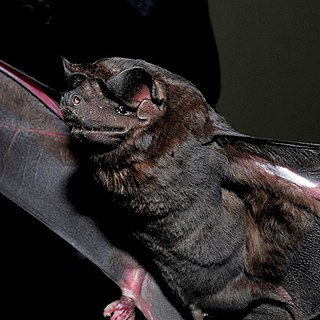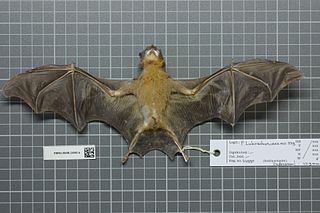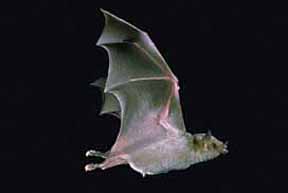
The New World leaf-nosed bats (Phyllostomidae) are found from southern North America to South America, specifically from the Southwest United States to northern Argentina. They are ecologically the most varied and diverse family within the order Chiroptera. Most species are insectivorous, but the phyllostomid bats include within their number true predatory species and frugivores. For example, the spectral bat, the largest bat in the Americas, eats vertebrate prey, including small, dove-sized birds. Members of this family have evolved to use food groups such as fruit, nectar, pollen, insects, frogs, other bats, and small vertebrates, and in the case of the vampire bats, even blood.

The spectral bat, also called the great false vampire bat or Linnaeus's false vampire bat, is a large, carnivorous leaf-nosed bat found in Mexico, Central America, and South America. It is the only member of the genus Vampyrum; its closest living relative is the big-eared woolly bat. It is the largest bat species in the New World, as well as the largest carnivorous bat: its wingspan is 0.7–1.0 m (2.3–3.3 ft). It has a robust skull and teeth, with which it delivers a powerful bite to kill its prey. Birds are frequent prey items, though it may also consume rodents, insects, and other bats.

The hairy-legged vampire bat is one of three extant species of vampire bats. It mainly feeds on the blood of wild birds, but can also feed both on domestic birds and humans. This vampire bat lives mainly in tropical and subtropical forestlands of South America, Central America, and southern Mexico. It is the sole member of the genus Diphylla.

Spix’s disk-winged bat, is a species of bat in the family Thyropteridae. It is native to the Americas from Mexico to Brazil. The most prominent anatomical feature of this bat, which distinguishes it from other species, is the disks on its thumbs and hind feet. These circular disks act as suction cups, allowing the bats to cling onto and move along smooth surfaces.

The black mastiff bat is a bat species. It ranges from the northern region of South America, most of Central America and parts of southern Mexico.

The tricolored big-eared bat is a bat species from South and Central America.

The yellow-throated big-eared bat or orange-throated bat(Lampronycteris brachyotis) is a species of bat from South and Central America, where it ranges from southern Mexico to Brazil. It is monotypic within the genus Lampronycteris. A frugivore and insectivore, it is found in lowland forest up to an elevation of 700 m. Its activity is greatest in the first two hours after sunset, and peaks again after midnight.

The dark long-tongued bat is a species of bat from South and Central America. It was formerly considered monotypic within the genus Lichonycteris, but is now recognized as one of two species in that genus, along with the pale brown long-nosed bat. It is small species of bat, with adults weighing 6–11 g (0.21–0.39 oz) and having a total length of 46–63 mm (1.8–2.5 in).

The northern sword-nosed bat is a bat species from South America. It is found in Brazil, French Guiana, Suriname and Venezuela.

Marinkelle's sword-nosed bat is a bat species from South America. It is found in Colombia. In 2013, Bat Conservation International listed this species as one of the 35 species of its worldwide priority list of conservation. Its species name marinkellei was chosen to honor the Dutch scientist Cornelis Johannes Marinkelle, who worked in Colombia.

The pygmy round-eared bat is a bat species from South and Central America.

The fringe-lipped bat is a leaf-nosed bat from southern Mexico to Bolivia and southern Brazil. It has three subspecies and no known fossils. It is the only species within its genus.

Niceforo's big-eared bat is a bat species from South and Central America, ranging from Chiapas to Bolivia and northeastern Brazil. Its habitat is primary and secondary forest at altitudes from sea level to 1000 m. It is crepuscular, being most active in the hour after sunset and before dawn. The species is monotypic within its genus.

Lonchorhina is a genus of Central and South American bats in the family Phyllostomidae.

The greater long-nosed bat or Mexican long-nosed bat is a species of bat in the family Phyllostomidae. It is found in Mexico and the United States. It chiefly consumes pollen and nectar, particularly from agave plants and cacti. Its habitat includes desert scrub and open woodlands. It is threatened by habitat loss.

Fernandez's sword-nosed bat is a species of bat in the family Phyllostomidae. It is the smallest species of the Lonchorhina genus. It is endemic to Venezuela. In 2013, Bat Conservation International listed this species as one of the 35 species of its worldwide priority list of conservation. It is threatened by habitat loss. It derives its scientific name from a Venezuelan zoologist, Dr. Alberto Fernandez Badillo, whose research focused on vampire bats, in particular.

The Jamaican flower bat is a critically endangered species of bat in the family Phyllostomidae. It is endemic to Jamaica.

Phyllostominae is a subfamily of bats that include big-eared, spear-nosed, sword-nosed bats and relatives.

The Thomas's shaggy bat is a bat species from South America. It was previously included in the shaggy bat but Simmons and Handley (1998) showed that the species were distinct.
Kathrin Barboza Marquez is a Bolivian biologist who is an expert in bat research. In 2006, she and a research partner discovered a species thought to be extinct and in 2010, she was awarded the National Geographic's "Young Explorer Grant". She became the first Bolivian scientist to win a L'Oréal-UNESCO Fellowship for Women in Science in 2012 and in 2013 was named by the BBC as one of the top ten Latin American women of science.




















